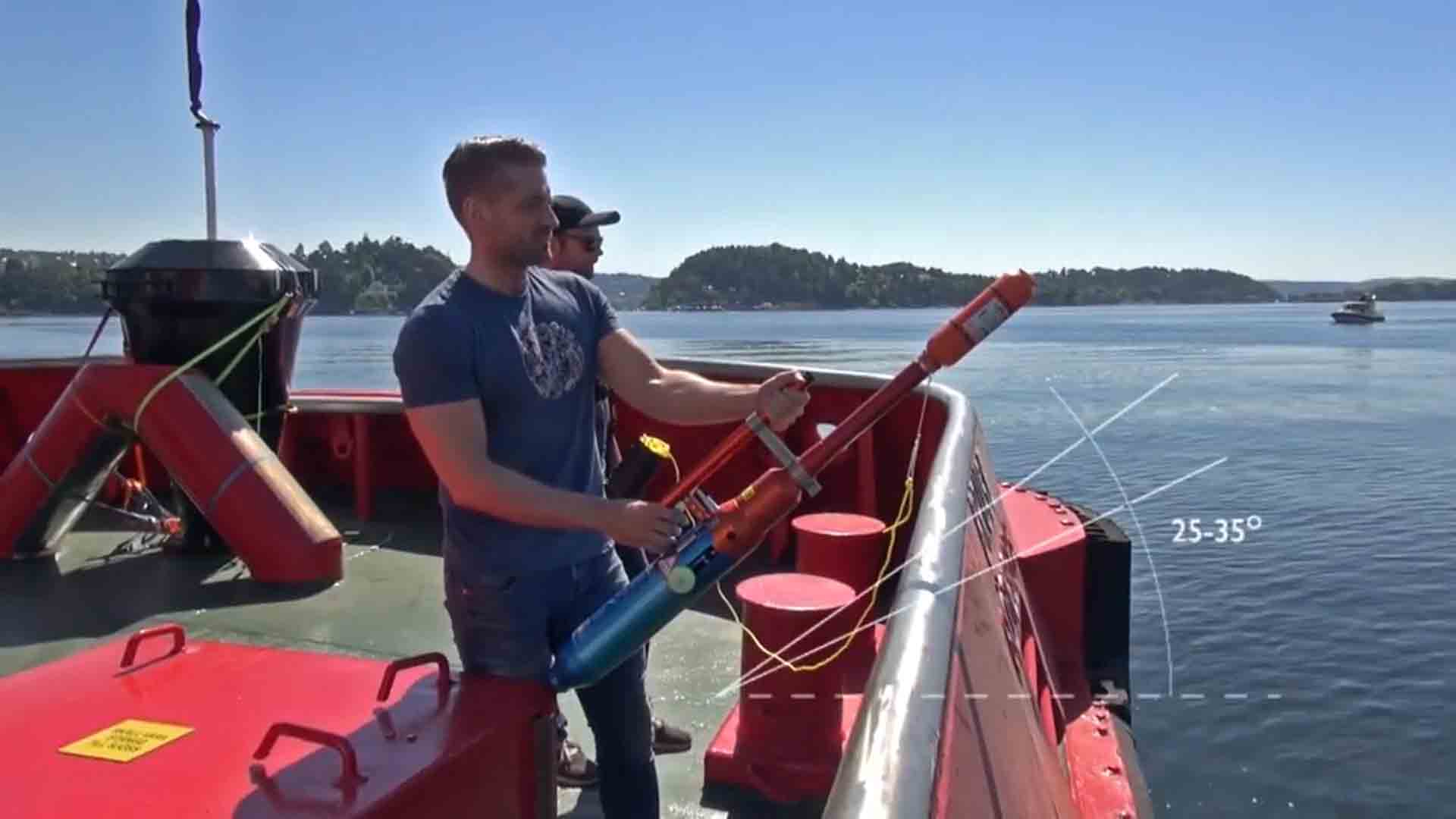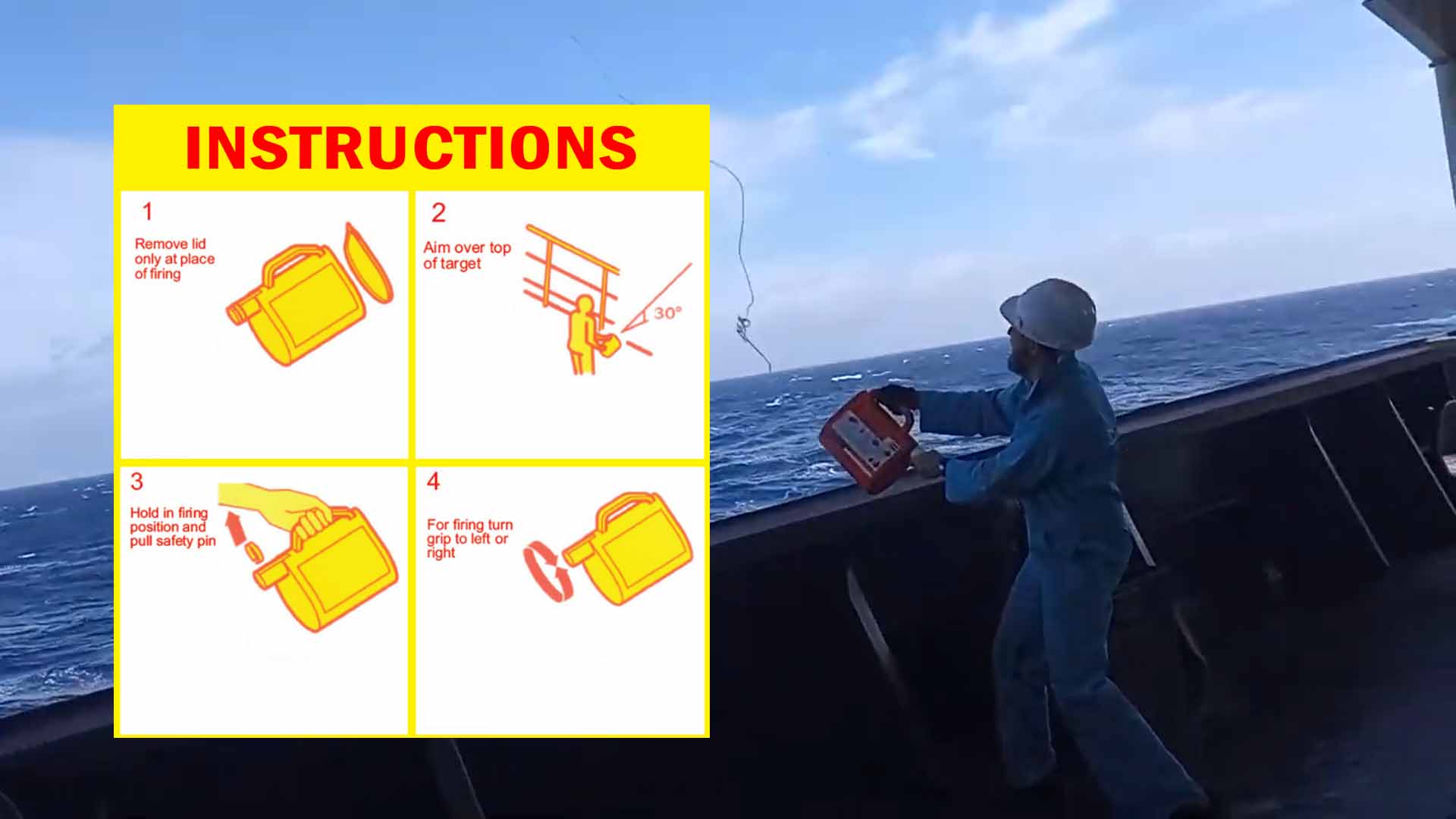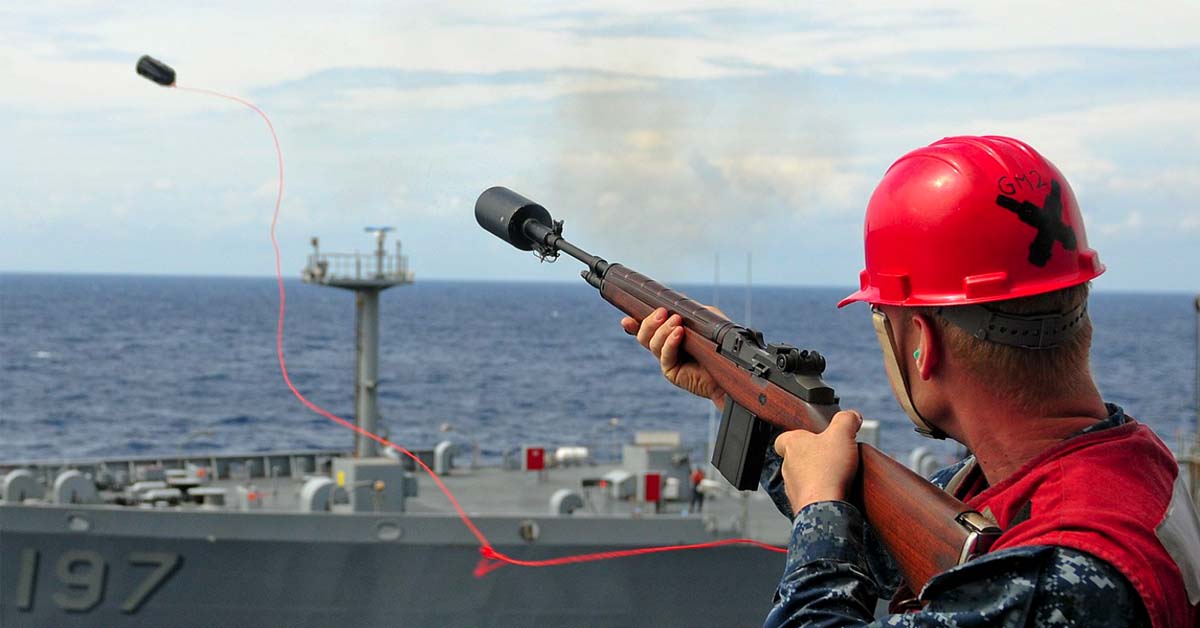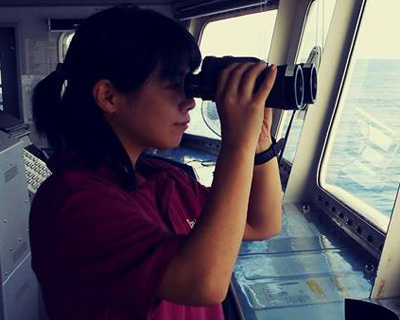A line-throwing apparatus (LTA) is a self-contained device that shoots a rocket projectile to a considerable distance while attached to a line.
It is mostly used during rescue operations but sometimes on a ship-to-ship transfer where normal methods of contact using heaving lines don’t work.
Since the use of LTA on ships is essential, SOLAS regulation and the LSA Code (Life Saving Appliance Code) standardize the construction and performance of this portable equipment.
Construction
As mentioned above, the Life-Saving Appliance Code (LSA Code) and SOLAS give guidelines for manufacturers to consider when crafting line-throwing devices.
These standards guarantee that they will work well for their intended purpose.
Thus, a line-throwing appliance shall:
- be constructed with proper workmanship and materials;
- in the case of an integral rocket and line, be contained in a water-resistant casing; in the case of a pistol-fired rocket, the rocket shall be contained in a water-resistant casing;
- include not less than four projectiles;
- include not less than four lines each having a breaking strength of not less than 2 kiloNewtons; and
- be so designed that the end from which the rocket is ejected can be positively identified by day or night.
- rockets, cartridges, and igniters shall be so constructed that all components, compositions, and ingredients shall be of such character and quality to maintain serviceability under good average storage conditions in the marine environment for a period of at least 4 years.
- Rockets, cartridges, and igniters shall be so constructed that any sealing shall not depend on adhesive tapes or plastic envelopes.
For reference, 2 kiloNewtons (kN) is equal to 203.94 kilograms.

Performance
The construction of line throwers must also satisfy specific performances that users expect to achieve.
Thus, the types of line-throwing appliances listed below follow these specifications.
- A line-throwing appliance shall be capable of throwing a line not less than 4 millimeters in diameter at a distance of at least 230 meters in calm weather. Proper training will enable you to aim for it with reasonable accuracy!
- A line-throwing appliance shall be capable of throwing a line in such a manner that the lateral defection on either side of the direction of firing does not exceed 10 percent of the length of the flight of the rocket in calm weather.
Markings
Like many equipment and devices found on board, markings play an important role. SOLAS and LSA require specific markings written on these devices so seafarers can use them correctly.
- A line-throwing appliance shall be marked with brief instructions or diagrams clearly illustrating the use of the appliance.
- The date of manufacture and the date of expiry shall be marked indelibly on the rockets, cartridges, and igniters.
Types of Line-Throwing Apparatus
Tanker vessels, containers, bulk carriers, and other types of merchant ships engaged in international voyages must carry line-throwing apparatus.
Since the line thrower shoots a projectile, it uses propellants or mechanisms for launching a solid weight into the air in a specified range.
To achieve that, line-throwing devices use three launching methods namely gun, rocket, and pneumatic.
1. Line-Throwing Gun
A line-throwing gun looks like a rifle. But instead of bullets shooting out of the barrel, a projectile is instead used which is also attached to a very long rope or line.
The same solid brass projectile goes into the gun’s barrel while a heavy load blank cartridge drives the projectile when fired.
With its versatility, users can fire a line-throwing gun on its shoulders, just like you do with a normal rifle.

The only drawback of this device is its bulkiness and so many moving parts.
Before you can use it, you have to assemble the projectile into the gun and insert the blank cartridge.
These extra components are stored in a container that can be as big as your medium-sized luggage.
They require bigger spaces for storage inside the bridge especially if you keep four of them which is according to SOLAS regulation.
2. Pneumatic Line Thrower
Another type of line-throwing apparatus is the Pneumatic Line Thrower which uses compressed air as its launching medium.
Pneumatic Line Throwers consist of different parts that you can assemble or disassemble.
Its launching unit is filled with compressed air of up to 200 to 300 bars.
With it, you can connect a launching tube depending on the type of projectile you will use. You can even launch a soft rubber ball with it just like throwing a heaving line to the shore.
Because of the simplicity of its launching medium, pneumatic line throwers are reusable with no expiration on all of their parts.
If used up, you can refill the air on its launching unit using a BA Compressor found on your ship.

The drawback of this device is the sheer number of projectiles to choose from. The incorrect one may not get the job done.
Compressed air also reacts with the ambient temperature and sailing with it from a hot to cold climate may affect its pressure.
Moreover, some types need two people to operate- one for firing the projectile and the other person holding the line pickup.
3. Rocket Line-Throwing Apparatus
The last and most commonly used line-throwing device in merchant vessels is the rocket-propelled line-throwing apparatus.
This device is robust, very handy, and straightforward to use without the need for extra steps when setting up.
It consists of a line attached to a rocket projectile found inside a waterproof plastic container. The rocket projectile rests on the trigger where the user twists upon firing.
When it expires, the only part that you have to replace is the rocket. The line, container, and trigger can stay as they are.
Another good thing about rocket line throwers is that they require a single person to operate. The rocket propellant is a pyrotechnic and treated as a hazardous item- thus its drawback.
How to use a line-throwing apparatus
Also called line-throwing cannons, these life-saving devices are very simple to use and can be operated with a few steps even though they differ in their launching mechanisms.
Gun and Pneumatic LTAs
For Gun and Pneumatic throwers, their design is to hold them like a rifle.
Hence, one of its ends rests against the shoulder of the user to keep it steady. You may have to assemble a few components first as part of its setup.
Before firing, it is very important to consider the strength and direction of the wind. Doing so helps adjust your aim and the direction of the projectile.
A good angle to consider when firing is 20 to 30 degrees above the horizon.
Rocket-type
For Rocket-type line-throwing apparatus, the steps are similar but the position of the device when firing differs.
Since it doesn’t look like a gun but a cylindrical cartridge, leaning it against the shoulder is not proper.

Here are the simple steps.
- Remove the lid only at the place of firing.
- Aim over at the top of the target preferably at 20 to 30 degrees above the horizon.
- Hold in the firing position and pull the safety pin.
- For firing, turn the grip to the left or right.
May the winds be in your favor.



0 Comments